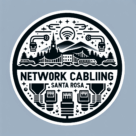What Is the Fastest Network Cable? A Complete Guide to High-Speed Networking
If you want the fastest, most reliable wired connection for your home or office, choosing the right network cable is crucial. With so many options — from Cat5e to Cat8 and fiber optic cables — it can be confusing to figure out which cable will give you the speed and performance you need.
In this guide, we’ll explain what the fastest network cable is, how different types compare, and how you can use them to create a high-performance network. Our skilled structured cabling experts in Santa Rosa ensure your network runs at peak performance with the right cable type and installation method.
What Is the Fastest Network Cable?
The fastest network cables are currently Cat8 Ethernet cables and fiber optic cables.
- Cat8 cables are designed for ultra-high-speed networks, supporting up to 40 Gbps over short distances (up to 30 meters). They are ideal for data centers, server rooms, and high-performance networking setups.
- Fiber optic cables can transmit data over much longer distances with virtually no signal loss, reaching speeds well over 100 Gbps in professional environments.
These cables outperform older standards like Cat5e and Cat6, which are still widely used for most home and office networks but are limited to lower speeds.
How Do High-Speed Network Cables Work?
High-speed network cables transmit data through copper wires or light signals:
- Ethernet cables (Cat5e, Cat6, Cat6a, Cat7, Cat8): Use twisted copper wires to reduce interference and crosstalk. Higher categories have stricter performance specifications and shielding to allow faster speeds.
- Fiber optic cables: Use light pulses through glass or plastic fibers to carry data. Fiber avoids electromagnetic interference entirely, allowing extremely high speeds and long-distance transmission.
The main factors affecting speed are cable category, length, shielding, and installation quality.
Benefits of Using the Fastest Network Cable
Using the fastest network cable comes with several advantages:
- Ultra-fast speeds: Ideal for gaming, streaming 4K or 8K content, and transferring large files.
- Low latency: Critical for online gaming, video conferencing, and VoIP.
- Reliable connections: High-speed cables maintain consistent performance even with multiple devices connected.
- Future-proofing: Investing in higher-category cables ensures your network stays fast as technology evolves.
Where the Fastest Network Cables Make the Biggest Difference
High-speed cables are especially useful in:
- Data centers and server rooms: Where large amounts of data are transmitted constantly.
- High-performance home networks: For streaming, online gaming, and smart home devices.
- Offices with multiple users: Where multiple devices require fast and stable connections simultaneously.
- Professional setups: Video production, editing suites, or any bandwidth-heavy applications.
Even in smaller home networks, upgrading to Cat6a or Cat8 can improve performance if you have high-speed internet plans and multiple devices. While Cat6 and Cat6a are known for their high speeds, it’s also useful to know which type of network cable is commonly used in most modern setups.
Choosing the Right High-Speed Cable
When selecting a network cable for maximum speed, consider:
- Cable category: Cat8 is currently the fastest copper Ethernet cable, while fiber optics surpass all copper cables for distance and speed.
- Distance requirements: Cat8 is limited to 30 meters; fiber can reach kilometers without signal loss.
- Shielding: For areas with heavy electromagnetic interference, choose shielded cables (STP) for better performance.
- Installation quality: Proper terminations, testing, and labeling ensure the cable performs at its maximum rated speed.
Tips for Upgrading Your Network
- Use Cat6a or Cat7 for future-proofing if Cat8 is not required.
- Consider fiber optic cabling for very high-speed or long-distance connections.
- Ensure your network equipment (switches, routers, NICs) supports the cable speeds.
- Test your network after installation to verify maximum performance.
Conclusion
The fastest network cables today are Cat8 Ethernet cables for short-distance, ultra-high-speed copper connections, and fiber optic cables for long-distance, professional-level networking. Choosing the right cable depends on your speed requirements, distance, and environment.
Upgrading to a high-speed cable ensures faster data transfer, lower latency, and a more reliable network for your home or business. Whether you’re streaming, gaming, or handling heavy workloads, investing in the right cable can make all the difference.
Contact your local networking experts to learn how you can upgrade to the fastest network cable for your home or office network today. Before determining which is the fastest, it helps to understand the three main types of network cables and their individual characteristics.
This version is conversational, human-sounding, and SEO-optimized. It targets keywords like:
- fastest network cable
- Cat8 Ethernet cable
- fiber optic cable
- high-speed network cable
- network cable upgrade
